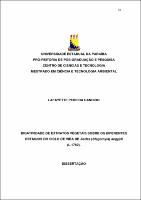| Compartilhamento |


|
Use este identificador para citar ou linkar para este item:
http://tede.bc.uepb.edu.br/jspui/handle/tede/1857| Tipo do documento: | Dissertação |
| Título: | Bioatividade de extratos vegetais sobre os diferentes estágios do ciclo de vida de Aedes (Stegomyia)aegypti (L.1762) |
| Autor: | Candido, Lafayette Pereira  |
| Primeiro orientador: | Beserra, Eduardo Barbosa |
| Primeiro membro da banca: | Lopez, Luiz Carlos Serramo |
| Segundo membro da banca: | Batista, Jacinto de Luna |
| Terceiro membro da banca: | Gusmão, Maria Avany Bezerra |
| Resumo: | Aedes aegypti é o principal responsável pela transmissão dos vírus da dengue e febre amarela. O desenvolvimento de resistência aos inseticidas sintéticos e sua toxidade levam à busca de novos métodos como, por exemplo, a utilização de extratos vegetais. Neste sentido, o presente trabalho avaliou os efeitos dos extratos de Cnidosculos phyllacanthus, Coutarea hexandra e Ricinus communis sobre os diferentes estágios do ciclo de vida do A. aegypti. Os testes de bioatividade vegetal foram realizados em sala climatizada a 26°C±2ºC e fotofase de 12 horas. Utilizaramse os extratos brutos do caule de C. phyllacanthus e C. hexandra, concentrados em evaporador rotativo e a semente para obtenção do óleo de R. communis e C. phyllacanthus. Nos bioensaios foram avaliados os efeitos larvicida, pupicida e adulticida desses produtos em função de diferentes concentrações e do tempo de exposição. O efeito sub letal, ovicida e de repelência de oviposição dos extratos vegetais foi realizado utilizando as concentrações letais do teste larvicida (CL50 e CL90). A repelência de superfície impregnada com os produtos vegetais foi feito com as dose de 0,5 mg/cm2 e 2 mg/cm2, no período de 8 horas. Os dados de mortalidade foram submetidos à Análise de Probit para a determinação das (CL50 e CL90). As médias referentes à preferência para oviposição em múltipla escolha foram comparadas pelo teste de Friedman (P<0,05) e sem chance de escolha pelo teste de Kruskal-Wallis (P<0,05). Os óleos vegetais de C. phyllacanthus e R. communis demonstraram maior eficiência no controle larval com CL50 = 0,55ml e CL90 = 3ml e CL50 = 0,05ml e CL90 = 0,50ml. No teste com pupas, verificou-se efeito toxico de todos os produtos com valores significativos das (CL50 e CL90) após 24 e 48 horas de exposição. Para o efeito Sub Letal e adulticida as concentrações de C. phyllacanthus (óleo) agiram mais efetivamente sobre inseto. Todos os produtos através dos valores IOA demonstraram ação repelente na oviposição de A. aegypti, porém, as concentrações dos extratos indicaram pouca atividade ovicida. Os óleos vegetais de C. phyllacanthus e R. communis demonstraram maior potencialidades no controle dos diferentes estágios do ciclo de vida desse vetor. |
| Abstract: | Aedes aegypti, is responsible for the transmission of the viruses of the affection and the yellow fever. The development of resistance to the synthetic insecticides and its toxicity take the search of new methods as, for example, the naturals extract use. The present work evaluated the effect of extracts of Cnidosculos phyllacanthus, Coutarea hexandra and Ricinus communis on the different periods of training of the cycle of life of A.aegypti. The tests of plant aticvidad had been carried through in acclimatized room 26°C±2ºC and fotofase of 12 hours. One used rude extracts of trunk of C. phyllacanthus and C. hexandra, concentrated in rotating evaporator and the seed for attainment of the oil of R. communis. In the bioassays the effect had been evaluated larvicide, pupicide and adulticide of these products in function of different concentrations and the time of exposition. Lethal, ovicidal the effect sub and of repellency of oviposição of vegetal extracts was carried through using the lethal concentrations of the larvicide test (CL50 and CL90). The repellency of surface impregnated with the vegetal products was carried through using the dose of 0,5mg/cm2 and 2mg/cm2, in the period of 8 hours. The mortality data had been submitted to the Analysis of Probit for the determination of (CL50 and CL90). Mean values for the preference for oviposition in multiple choice were compared by Friedman test (P <0.05) and no-choice by Kruskal-Wallis (P <0.05). Vegetable oils of C. phyllacanthus and R. communis showed a greater efficiency in controlling larval CL50 = 0.55 ml and CL90 = 3ml and CL50= 0.05 ml and CL90 = 0.50 ml more promising. In the test with pupae, it was found toxic effect of all products containing significant amounts of (CL50 and CL90) after 24 and 48 hours of exposure. To this end sub-lethal concentrations of adulticide and C. phyllacanthus (oil) acted more effectively on the insect. All products through the IOA values showed repellent action on oviposition of A. aegypti, however, the concentrations of the extracts showed little ovicidal activity. Vegetable oils of C. phyllacanthus and R. communis showed more potential in controlling the different stages of the life cycle of this vector. |
| Palavras-chave: | Aedes aegypti Dengue Extratos vegetais Aedes aegypti Dengue Plant extracts |
| Área(s) do CNPq: | CNPQ::CIENCIAS HUMANAS::GEOGRAFIA |
| Idioma: | por |
| País: | BR |
| Instituição: | Universidade Estadual da Paraíba |
| Sigla da instituição: | UEPB |
| Departamento: | Tecnologia Ambiental |
| Programa: | Mestrado em Ciência e Tecnologia Ambiental - MCTA |
| Citação: | CANDIDO, Lafayette Pereira. Bioatividade de extratos vegetais sobre os diferentes estágios do ciclo de vida de Aedes (Stegomyia)aegypti (L.1762). 2011. 112 f. Dissertação (Mestrado em Tecnologia Ambiental) - Universidade Estadual da Paraíba, Campina Grande, 2011. |
| Tipo de acesso: | Acesso Aberto |
| URI: | http://tede.bc.uepb.edu.br/tede/jspui/handle/tede/1857 |
| Data de defesa: | 31-Jan-2011 |
| Aparece nas coleções: | PPGCTA - Dissertações |
Arquivos associados a este item:
| Arquivo | Descrição | Tamanho | Formato | |
|---|---|---|---|---|
| PDF - Lafayette Pereira Candido.pdf | 2.23 MB | Adobe PDF |  Baixar/Abrir Pré-Visualizar |
Os itens no repositório estão protegidos por copyright, com todos os direitos reservados, salvo quando é indicado o contrário.




